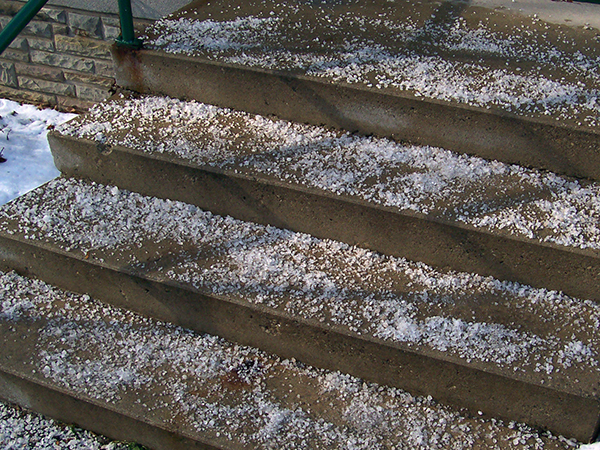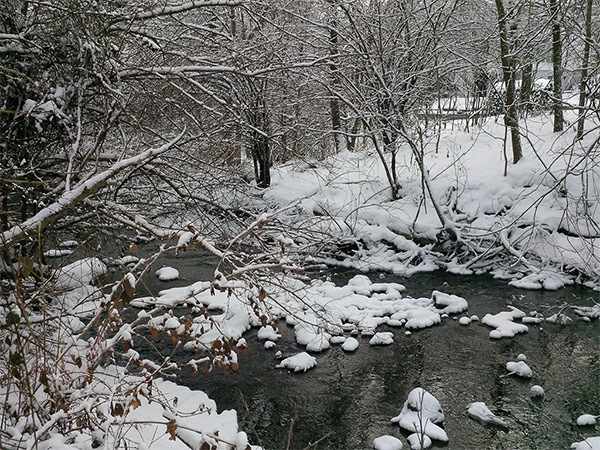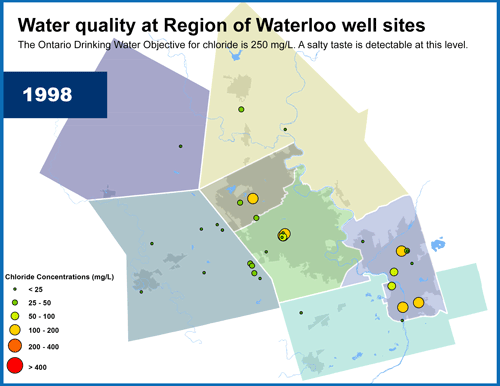More and more, salt is becoming a normal part of the winter landscape. As one of the many tools used to clear snow and ice, salt is spread over most surfaces where you walk, bike, drive and park your vehicle. That’s a lot of area covered in salt!

You might not think of salt as a pollutant. However, TVO’s article Oversalted: Why Ontario needs a new approach to snow removal states “Environment Canada completed a five-year study in 2001 that concluded road salt should be added to its list of toxic substances, although the department did not actually ban the use of road salt.”
Keeping everyone safe and protecting the environment can be a tough balancing act. But using too much salt or when not needed isn’t good for plants, pets’ paws, cars, and buildings. If you have read my blog “The hidden costs of winter salt and ice melter you might not know about” you’ll know what I mean.
But what about fresh water in lakes and streams and me – groundwater? Is salt really that bad for water? Doesn’t salt just go away after it melts the ice and if not, can’t technology be used to simply remove the salt from water?

Did you know?
- Salt is a long-term pollutant that stays with water. Once salt is spread on the ground it stays in the environment. You might not see the salt anymore after the snow melts or when the salt is washed away with the rain but it’s still there. The salt can soak into the ground to mix with me and will build up over time or enter a local waterway through a storm drain.
- Water and wastewater treatment does not remove salt from water. Removing salt requires desalination which is extremely expensive and energy intensive, and greatly increases greenhouse gases. Including desalination as part of the treatment process would also result in much higher water costs for the community.
- When talking about water pollution, it’s the chloride in the salt and ice melter products that’s the problem. This includes environmentally-friendly products. Basically, if it melts the ice it most likely contains chloride and is damaging to water.
Salt impacts the taste of drinking water
For drinking water, it’s all about the taste. The Ontario Drinking Water Objectives for chloride is 250mg/L. This is when a salty taste may be detectable by some people.
The maps below compare the chloride levels from 1998 and 2018 at the Region of Waterloo drinking water supply wells. The orange and red dots are groundwater wells with chloride levels near or exceeding the 250 mg/L limit. Currently, the Region of Waterloo must mix groundwater from different wells to lower the chloride levels.

Salt is harmful to aquatic life
The Canadian Water Quality Guideline states for the protection of aquatic life that the long term exposure of chloride levels for freshwater should be below 120 mg/L.
Did you know a dragonfly eats hundreds of mosquitoes every day? Unfortunately, a salty pond can impact their numbers. A CBC article Salty dragonflies mean more mosquitoes, researchers reported in a study on how increased salt levels in a pond had little affect on mosquito larvae but were impacting dragonfly larvae.
Non-native or invasive species can also begin taking over areas meant for native wildlife. The price of salt: How road salts are affecting our Great Lakes written by Lake Ontario WaterKeeper shares how “Spots in Ontario have become so salty that there have been sightings of saltwater animals in the freshwater creeks. Reports of saltwater blue crabs living in Mimico Creek is just one troubling case that illustrates the extent of sodium chloride pollution in watersheds of Lake Ontario.”
Increasing salt levels in surface water is not limited to the GTA. The Grand River Conservation Authority measures water conductivity in the watershed. Although conductivity data does not measure chloride levels, it is an indicator that chloride is likely present.
Protecting water from salt pollution is a complex issue. It might not be realistic to stop salting completely; however, there are actions everyone can take to use less.
Salt is a normal part of the winter landscape. Salt is spread over most surfaces where you walk, bike, drive and park your vehicle. So is it really that bad for water? Read the I Am Groundwater blog to find out. #iamgroundwaterblog
Tweet
Related posts:
